Employment Relationship Challenges and Solutions: OHF Report
VerifiedAdded on 2022/12/14
|12
|3903
|204
Report
AI Summary
This report provides a comprehensive analysis of employment relationships within the context of Organic Health Food (OHF). It begins by emphasizing the importance of healthy employment relationships for organizational success and introduces the role of employment law in maintaining these relationships. The main body addresses several key issues, including racial discrimination, maternity leave rights, and compliance with the National Minimum Wage Act, using specific case scenarios to illustrate these points. The report delves into the legal implications of denying sick leave for gender reassignment and depression, highlighting the Equality Act 2010 and the rights of employees undergoing gender reassignment. Furthermore, the report examines the National Minimum Wage Act and its implications for apprentices and zero-hour contract staff, identifying discrepancies in OHF's proposed pay structure and the legal ramifications of non-compliance. The report concludes by offering recommendations to ensure OHF's adherence to employment law, promoting fair treatment of employees, and fostering positive employment relationships.

Managing the
Employment
Relationship
Employment
Relationship
Paraphrase This Document
Need a fresh take? Get an instant paraphrase of this document with our AI Paraphraser

Table of Contents
INTRODUCTION...........................................................................................................................3
MAIN BODY...................................................................................................................................3
Question 1:..............................................................................................................................3
Question 2:..............................................................................................................................5
Question 3:..............................................................................................................................6
Question 4:..............................................................................................................................8
CONCLUSION..............................................................................................................................11
REFERNCES.................................................................................................................................12
INTRODUCTION...........................................................................................................................3
MAIN BODY...................................................................................................................................3
Question 1:..............................................................................................................................3
Question 2:..............................................................................................................................5
Question 3:..............................................................................................................................6
Question 4:..............................................................................................................................8
CONCLUSION..............................................................................................................................11
REFERNCES.................................................................................................................................12
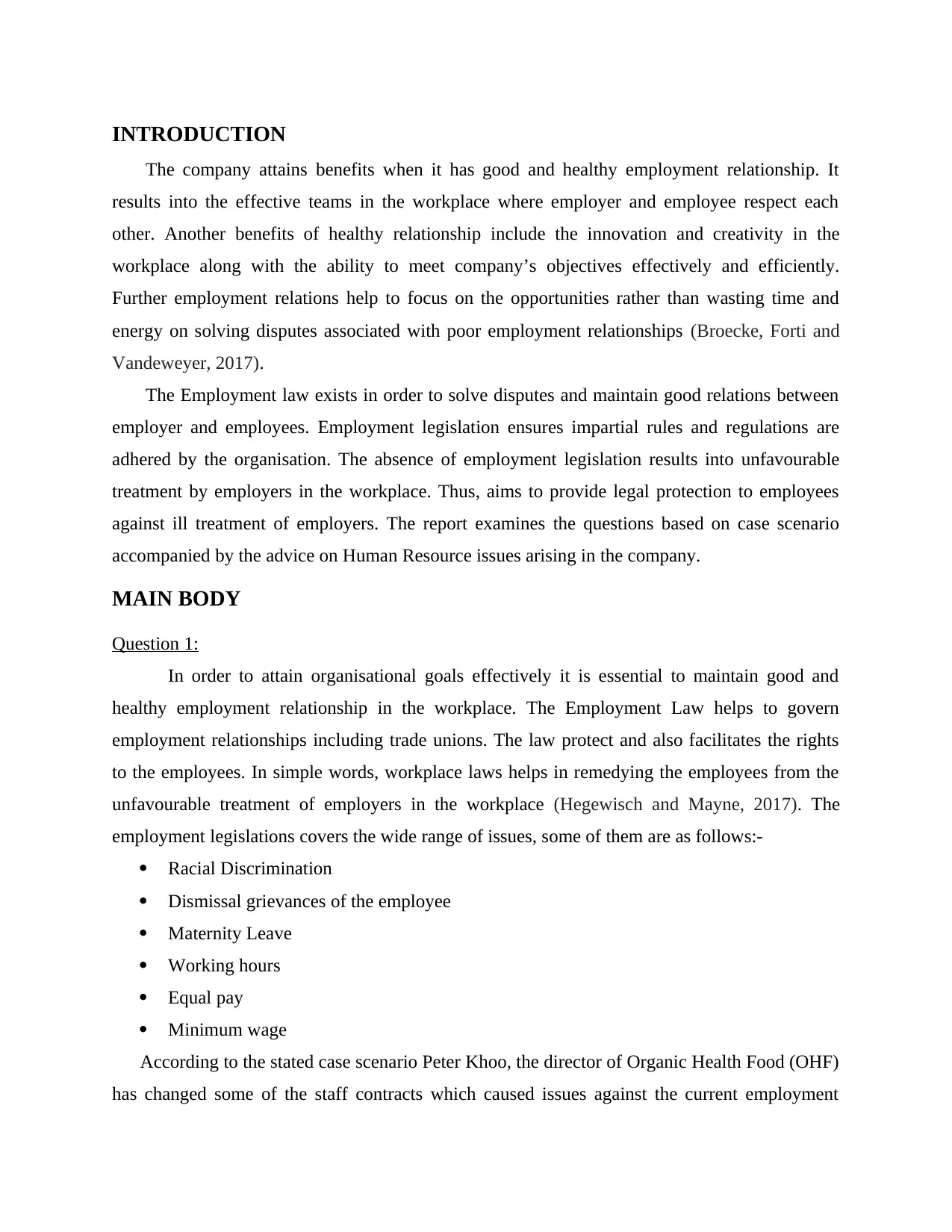
INTRODUCTION
The company attains benefits when it has good and healthy employment relationship. It
results into the effective teams in the workplace where employer and employee respect each
other. Another benefits of healthy relationship include the innovation and creativity in the
workplace along with the ability to meet company’s objectives effectively and efficiently.
Further employment relations help to focus on the opportunities rather than wasting time and
energy on solving disputes associated with poor employment relationships (Broecke, Forti and
Vandeweyer, 2017).
The Employment law exists in order to solve disputes and maintain good relations between
employer and employees. Employment legislation ensures impartial rules and regulations are
adhered by the organisation. The absence of employment legislation results into unfavourable
treatment by employers in the workplace. Thus, aims to provide legal protection to employees
against ill treatment of employers. The report examines the questions based on case scenario
accompanied by the advice on Human Resource issues arising in the company.
MAIN BODY
Question 1:
In order to attain organisational goals effectively it is essential to maintain good and
healthy employment relationship in the workplace. The Employment Law helps to govern
employment relationships including trade unions. The law protect and also facilitates the rights
to the employees. In simple words, workplace laws helps in remedying the employees from the
unfavourable treatment of employers in the workplace (Hegewisch and Mayne, 2017). The
employment legislations covers the wide range of issues, some of them are as follows:-
Racial Discrimination
Dismissal grievances of the employee
Maternity Leave
Working hours
Equal pay
Minimum wage
According to the stated case scenario Peter Khoo, the director of Organic Health Food (OHF)
has changed some of the staff contracts which caused issues against the current employment
The company attains benefits when it has good and healthy employment relationship. It
results into the effective teams in the workplace where employer and employee respect each
other. Another benefits of healthy relationship include the innovation and creativity in the
workplace along with the ability to meet company’s objectives effectively and efficiently.
Further employment relations help to focus on the opportunities rather than wasting time and
energy on solving disputes associated with poor employment relationships (Broecke, Forti and
Vandeweyer, 2017).
The Employment law exists in order to solve disputes and maintain good relations between
employer and employees. Employment legislation ensures impartial rules and regulations are
adhered by the organisation. The absence of employment legislation results into unfavourable
treatment by employers in the workplace. Thus, aims to provide legal protection to employees
against ill treatment of employers. The report examines the questions based on case scenario
accompanied by the advice on Human Resource issues arising in the company.
MAIN BODY
Question 1:
In order to attain organisational goals effectively it is essential to maintain good and
healthy employment relationship in the workplace. The Employment Law helps to govern
employment relationships including trade unions. The law protect and also facilitates the rights
to the employees. In simple words, workplace laws helps in remedying the employees from the
unfavourable treatment of employers in the workplace (Hegewisch and Mayne, 2017). The
employment legislations covers the wide range of issues, some of them are as follows:-
Racial Discrimination
Dismissal grievances of the employee
Maternity Leave
Working hours
Equal pay
Minimum wage
According to the stated case scenario Peter Khoo, the director of Organic Health Food (OHF)
has changed some of the staff contracts which caused issues against the current employment
⊘ This is a preview!⊘
Do you want full access?
Subscribe today to unlock all pages.

Trusted by 1+ million students worldwide
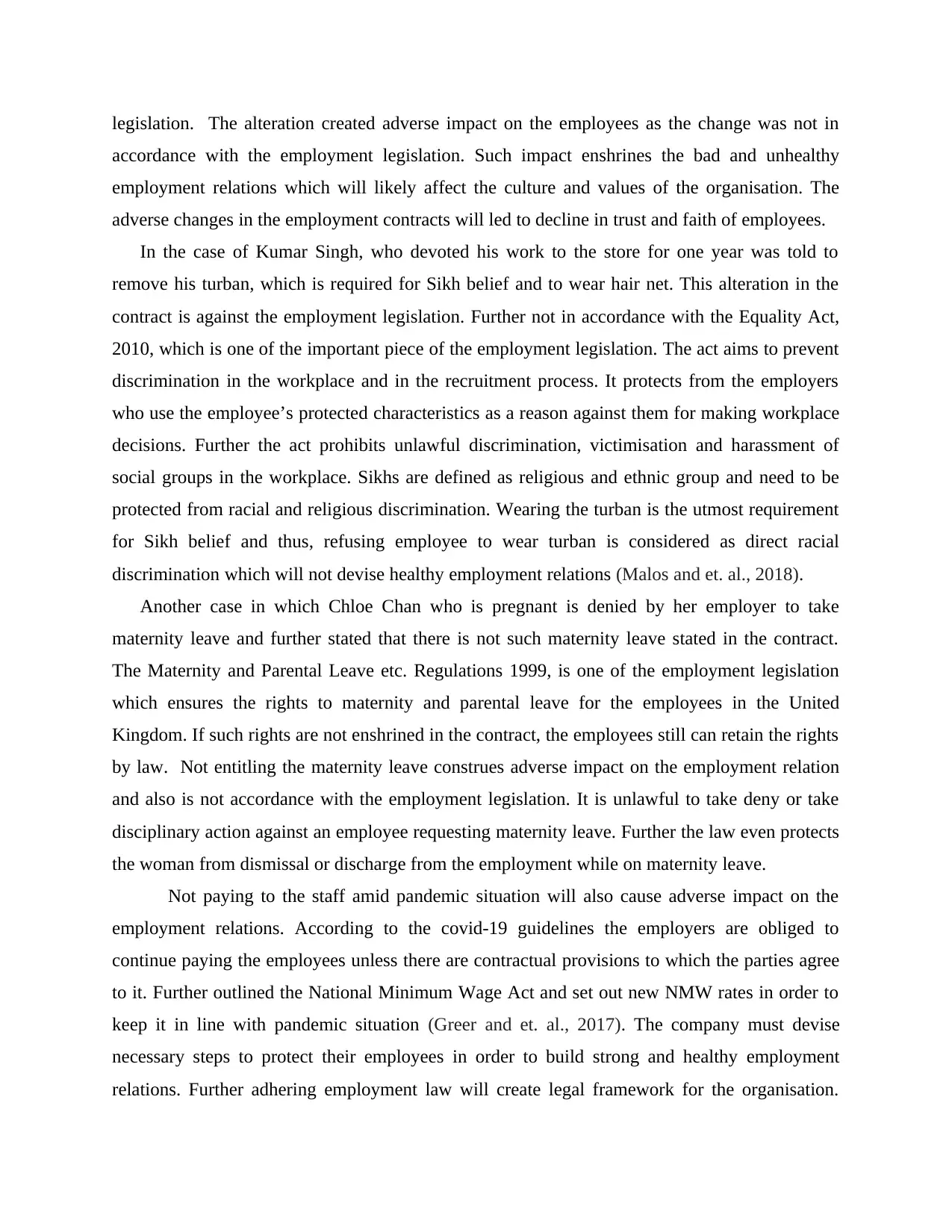
legislation. The alteration created adverse impact on the employees as the change was not in
accordance with the employment legislation. Such impact enshrines the bad and unhealthy
employment relations which will likely affect the culture and values of the organisation. The
adverse changes in the employment contracts will led to decline in trust and faith of employees.
In the case of Kumar Singh, who devoted his work to the store for one year was told to
remove his turban, which is required for Sikh belief and to wear hair net. This alteration in the
contract is against the employment legislation. Further not in accordance with the Equality Act,
2010, which is one of the important piece of the employment legislation. The act aims to prevent
discrimination in the workplace and in the recruitment process. It protects from the employers
who use the employee’s protected characteristics as a reason against them for making workplace
decisions. Further the act prohibits unlawful discrimination, victimisation and harassment of
social groups in the workplace. Sikhs are defined as religious and ethnic group and need to be
protected from racial and religious discrimination. Wearing the turban is the utmost requirement
for Sikh belief and thus, refusing employee to wear turban is considered as direct racial
discrimination which will not devise healthy employment relations (Malos and et. al., 2018).
Another case in which Chloe Chan who is pregnant is denied by her employer to take
maternity leave and further stated that there is not such maternity leave stated in the contract.
The Maternity and Parental Leave etc. Regulations 1999, is one of the employment legislation
which ensures the rights to maternity and parental leave for the employees in the United
Kingdom. If such rights are not enshrined in the contract, the employees still can retain the rights
by law. Not entitling the maternity leave construes adverse impact on the employment relation
and also is not accordance with the employment legislation. It is unlawful to take deny or take
disciplinary action against an employee requesting maternity leave. Further the law even protects
the woman from dismissal or discharge from the employment while on maternity leave.
Not paying to the staff amid pandemic situation will also cause adverse impact on the
employment relations. According to the covid-19 guidelines the employers are obliged to
continue paying the employees unless there are contractual provisions to which the parties agree
to it. Further outlined the National Minimum Wage Act and set out new NMW rates in order to
keep it in line with pandemic situation (Greer and et. al., 2017). The company must devise
necessary steps to protect their employees in order to build strong and healthy employment
relations. Further adhering employment law will create legal framework for the organisation.
accordance with the employment legislation. Such impact enshrines the bad and unhealthy
employment relations which will likely affect the culture and values of the organisation. The
adverse changes in the employment contracts will led to decline in trust and faith of employees.
In the case of Kumar Singh, who devoted his work to the store for one year was told to
remove his turban, which is required for Sikh belief and to wear hair net. This alteration in the
contract is against the employment legislation. Further not in accordance with the Equality Act,
2010, which is one of the important piece of the employment legislation. The act aims to prevent
discrimination in the workplace and in the recruitment process. It protects from the employers
who use the employee’s protected characteristics as a reason against them for making workplace
decisions. Further the act prohibits unlawful discrimination, victimisation and harassment of
social groups in the workplace. Sikhs are defined as religious and ethnic group and need to be
protected from racial and religious discrimination. Wearing the turban is the utmost requirement
for Sikh belief and thus, refusing employee to wear turban is considered as direct racial
discrimination which will not devise healthy employment relations (Malos and et. al., 2018).
Another case in which Chloe Chan who is pregnant is denied by her employer to take
maternity leave and further stated that there is not such maternity leave stated in the contract.
The Maternity and Parental Leave etc. Regulations 1999, is one of the employment legislation
which ensures the rights to maternity and parental leave for the employees in the United
Kingdom. If such rights are not enshrined in the contract, the employees still can retain the rights
by law. Not entitling the maternity leave construes adverse impact on the employment relation
and also is not accordance with the employment legislation. It is unlawful to take deny or take
disciplinary action against an employee requesting maternity leave. Further the law even protects
the woman from dismissal or discharge from the employment while on maternity leave.
Not paying to the staff amid pandemic situation will also cause adverse impact on the
employment relations. According to the covid-19 guidelines the employers are obliged to
continue paying the employees unless there are contractual provisions to which the parties agree
to it. Further outlined the National Minimum Wage Act and set out new NMW rates in order to
keep it in line with pandemic situation (Greer and et. al., 2017). The company must devise
necessary steps to protect their employees in order to build strong and healthy employment
relations. Further adhering employment law will create legal framework for the organisation.
Paraphrase This Document
Need a fresh take? Get an instant paraphrase of this document with our AI Paraphraser
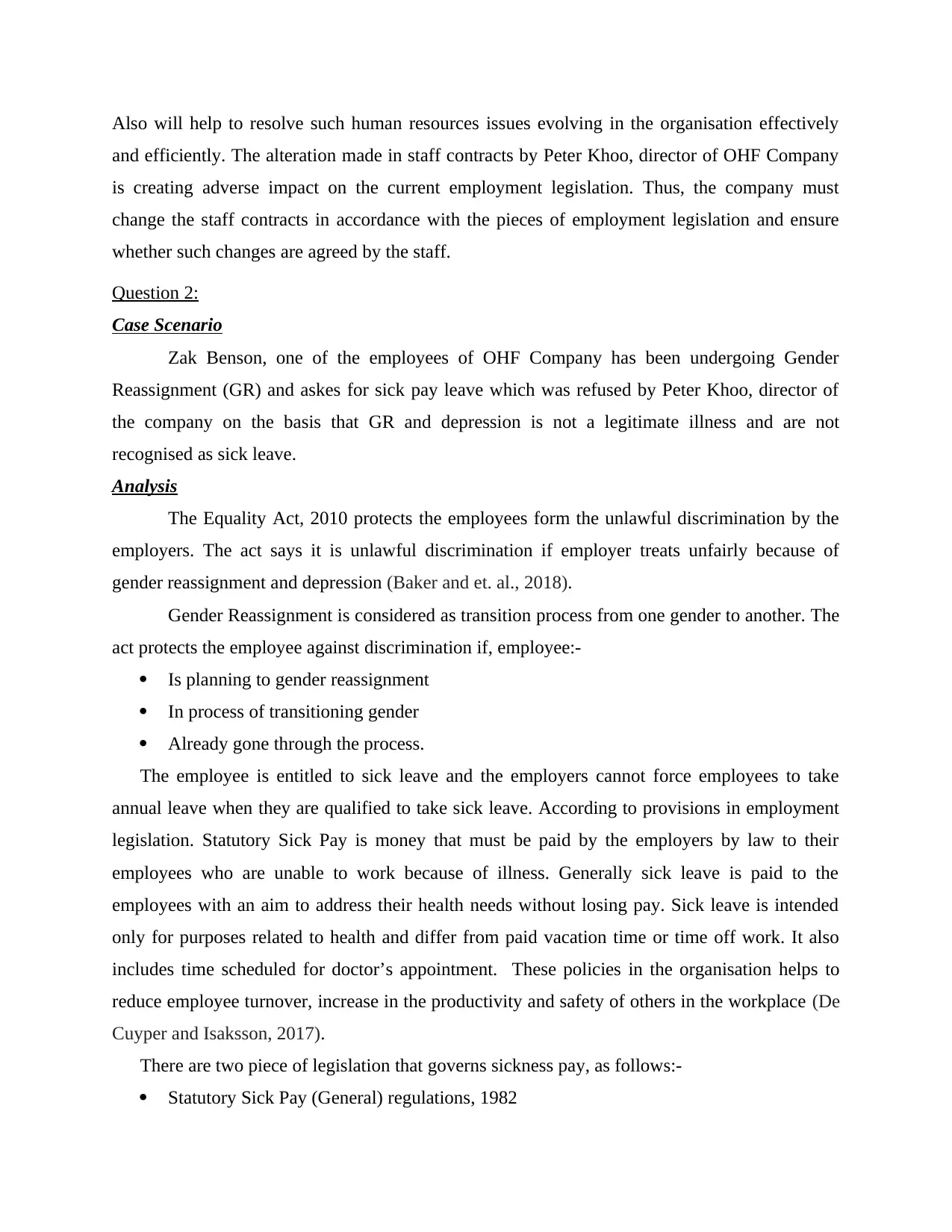
Also will help to resolve such human resources issues evolving in the organisation effectively
and efficiently. The alteration made in staff contracts by Peter Khoo, director of OHF Company
is creating adverse impact on the current employment legislation. Thus, the company must
change the staff contracts in accordance with the pieces of employment legislation and ensure
whether such changes are agreed by the staff.
Question 2:
Case Scenario
Zak Benson, one of the employees of OHF Company has been undergoing Gender
Reassignment (GR) and askes for sick pay leave which was refused by Peter Khoo, director of
the company on the basis that GR and depression is not a legitimate illness and are not
recognised as sick leave.
Analysis
The Equality Act, 2010 protects the employees form the unlawful discrimination by the
employers. The act says it is unlawful discrimination if employer treats unfairly because of
gender reassignment and depression (Baker and et. al., 2018).
Gender Reassignment is considered as transition process from one gender to another. The
act protects the employee against discrimination if, employee:-
Is planning to gender reassignment
In process of transitioning gender
Already gone through the process.
The employee is entitled to sick leave and the employers cannot force employees to take
annual leave when they are qualified to take sick leave. According to provisions in employment
legislation. Statutory Sick Pay is money that must be paid by the employers by law to their
employees who are unable to work because of illness. Generally sick leave is paid to the
employees with an aim to address their health needs without losing pay. Sick leave is intended
only for purposes related to health and differ from paid vacation time or time off work. It also
includes time scheduled for doctor’s appointment. These policies in the organisation helps to
reduce employee turnover, increase in the productivity and safety of others in the workplace (De
Cuyper and Isaksson, 2017).
There are two piece of legislation that governs sickness pay, as follows:-
Statutory Sick Pay (General) regulations, 1982
and efficiently. The alteration made in staff contracts by Peter Khoo, director of OHF Company
is creating adverse impact on the current employment legislation. Thus, the company must
change the staff contracts in accordance with the pieces of employment legislation and ensure
whether such changes are agreed by the staff.
Question 2:
Case Scenario
Zak Benson, one of the employees of OHF Company has been undergoing Gender
Reassignment (GR) and askes for sick pay leave which was refused by Peter Khoo, director of
the company on the basis that GR and depression is not a legitimate illness and are not
recognised as sick leave.
Analysis
The Equality Act, 2010 protects the employees form the unlawful discrimination by the
employers. The act says it is unlawful discrimination if employer treats unfairly because of
gender reassignment and depression (Baker and et. al., 2018).
Gender Reassignment is considered as transition process from one gender to another. The
act protects the employee against discrimination if, employee:-
Is planning to gender reassignment
In process of transitioning gender
Already gone through the process.
The employee is entitled to sick leave and the employers cannot force employees to take
annual leave when they are qualified to take sick leave. According to provisions in employment
legislation. Statutory Sick Pay is money that must be paid by the employers by law to their
employees who are unable to work because of illness. Generally sick leave is paid to the
employees with an aim to address their health needs without losing pay. Sick leave is intended
only for purposes related to health and differ from paid vacation time or time off work. It also
includes time scheduled for doctor’s appointment. These policies in the organisation helps to
reduce employee turnover, increase in the productivity and safety of others in the workplace (De
Cuyper and Isaksson, 2017).
There are two piece of legislation that governs sickness pay, as follows:-
Statutory Sick Pay (General) regulations, 1982
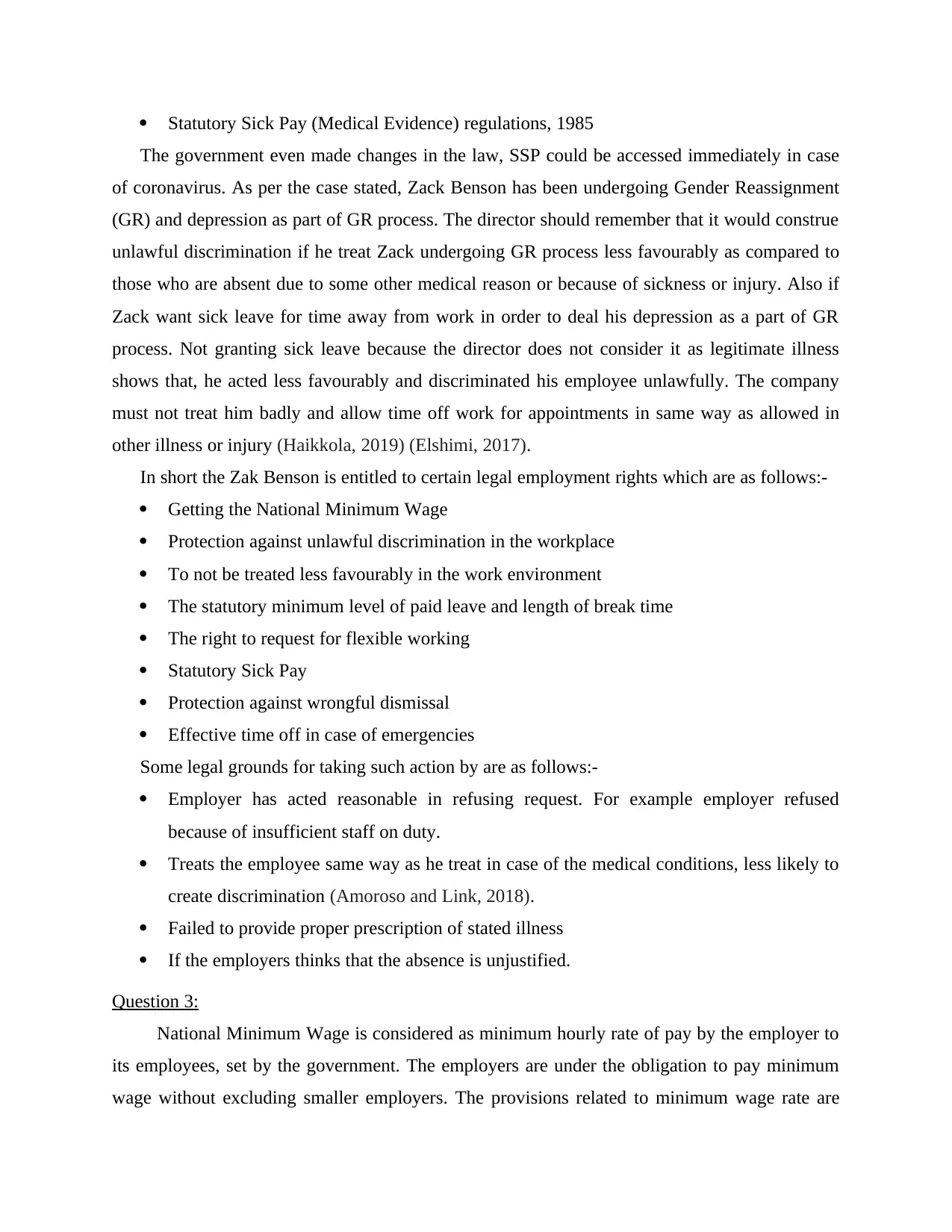
Statutory Sick Pay (Medical Evidence) regulations, 1985
The government even made changes in the law, SSP could be accessed immediately in case
of coronavirus. As per the case stated, Zack Benson has been undergoing Gender Reassignment
(GR) and depression as part of GR process. The director should remember that it would construe
unlawful discrimination if he treat Zack undergoing GR process less favourably as compared to
those who are absent due to some other medical reason or because of sickness or injury. Also if
Zack want sick leave for time away from work in order to deal his depression as a part of GR
process. Not granting sick leave because the director does not consider it as legitimate illness
shows that, he acted less favourably and discriminated his employee unlawfully. The company
must not treat him badly and allow time off work for appointments in same way as allowed in
other illness or injury (Haikkola, 2019) (Elshimi, 2017).
In short the Zak Benson is entitled to certain legal employment rights which are as follows:-
Getting the National Minimum Wage
Protection against unlawful discrimination in the workplace
To not be treated less favourably in the work environment
The statutory minimum level of paid leave and length of break time
The right to request for flexible working
Statutory Sick Pay
Protection against wrongful dismissal
Effective time off in case of emergencies
Some legal grounds for taking such action by are as follows:-
Employer has acted reasonable in refusing request. For example employer refused
because of insufficient staff on duty.
Treats the employee same way as he treat in case of the medical conditions, less likely to
create discrimination (Amoroso and Link, 2018).
Failed to provide proper prescription of stated illness
If the employers thinks that the absence is unjustified.
Question 3:
National Minimum Wage is considered as minimum hourly rate of pay by the employer to
its employees, set by the government. The employers are under the obligation to pay minimum
wage without excluding smaller employers. The provisions related to minimum wage rate are
The government even made changes in the law, SSP could be accessed immediately in case
of coronavirus. As per the case stated, Zack Benson has been undergoing Gender Reassignment
(GR) and depression as part of GR process. The director should remember that it would construe
unlawful discrimination if he treat Zack undergoing GR process less favourably as compared to
those who are absent due to some other medical reason or because of sickness or injury. Also if
Zack want sick leave for time away from work in order to deal his depression as a part of GR
process. Not granting sick leave because the director does not consider it as legitimate illness
shows that, he acted less favourably and discriminated his employee unlawfully. The company
must not treat him badly and allow time off work for appointments in same way as allowed in
other illness or injury (Haikkola, 2019) (Elshimi, 2017).
In short the Zak Benson is entitled to certain legal employment rights which are as follows:-
Getting the National Minimum Wage
Protection against unlawful discrimination in the workplace
To not be treated less favourably in the work environment
The statutory minimum level of paid leave and length of break time
The right to request for flexible working
Statutory Sick Pay
Protection against wrongful dismissal
Effective time off in case of emergencies
Some legal grounds for taking such action by are as follows:-
Employer has acted reasonable in refusing request. For example employer refused
because of insufficient staff on duty.
Treats the employee same way as he treat in case of the medical conditions, less likely to
create discrimination (Amoroso and Link, 2018).
Failed to provide proper prescription of stated illness
If the employers thinks that the absence is unjustified.
Question 3:
National Minimum Wage is considered as minimum hourly rate of pay by the employer to
its employees, set by the government. The employers are under the obligation to pay minimum
wage without excluding smaller employers. The provisions related to minimum wage rate are
⊘ This is a preview!⊘
Do you want full access?
Subscribe today to unlock all pages.

Trusted by 1+ million students worldwide

contained in National Minimum Wage Act 1998 and National Minimum Wage Regulations
2015, and the rates are based on the recommendations made by the Low Pay Commission (LPC).
Organic Health Food Company under the UK wage legislation has proposed the pay
structure which fails to comply the legal requirements of the latest changes in the NMW. The
proposed structure specifies that the Apprentices will not receive any wage during the training,
as apprentices spend 20 percent of their normal working hours training and thus, is required to be
paid for the time spent in training or studying for their apprenticeship (Cobb, 2017). The rates of
paying for apprentices differ depending on their age and the year they completed their
apprenticeship. The current national minimum wage rate for an apprentices are discussed below:-
Aged 16 to 18: £4.30 per hour to apprentice
Aged 19 or above and is in first year: apprentice is £4.30 per hour
Aged 19 or above and completed first year: Apprentices is entitled to National Minimum
Wage or National Living Wage Rate in accordance with their age.
Further employer must provide the apprentices in the same conditions as other employees
working in similar circumstances. In simple words, employer must offer without any
discrimination or any partial behaviour. It includes paid holidays, sick leave, any support or
benefits needed. Thus, the apprentices has same employment rights.
New rates came into force on April, 2021 in respect of National Living Wage (NLW) and
National Minimum Wage (NMW). As discussed above these rates are based on the
recommendations of Low Pay Commission. As per new rates, the NLW is applicable to all the
workers aged 23 and above. As per the structure proposed by the company showing the pay
structure changes provides National Minimum Wage (NMW) for 16 -17 years £1.80 and for 21-
24 years £8.90 which is not accordance with the latest UK wage legislation. According to the
new rates the NMW for 16-17 rear old rate is £4.62 and for 21-22 year old rate is £8.36, further
national Living Wage now applies for the workers aged 23 and over (Frey, 2017). The company
structure is breaching the NMW legislation and is required to pay arrears of wages to the
respective workers according to their current minimum wage rates. Even the company is liable to
pay hefty financial penalties to the government. The HMRC (HM Revenue & Customs) can take
employers to the court for not paying the NMW and NLW as per the current rates. Thus,
company must pay to its employees according to the new prevailing rates.
2015, and the rates are based on the recommendations made by the Low Pay Commission (LPC).
Organic Health Food Company under the UK wage legislation has proposed the pay
structure which fails to comply the legal requirements of the latest changes in the NMW. The
proposed structure specifies that the Apprentices will not receive any wage during the training,
as apprentices spend 20 percent of their normal working hours training and thus, is required to be
paid for the time spent in training or studying for their apprenticeship (Cobb, 2017). The rates of
paying for apprentices differ depending on their age and the year they completed their
apprenticeship. The current national minimum wage rate for an apprentices are discussed below:-
Aged 16 to 18: £4.30 per hour to apprentice
Aged 19 or above and is in first year: apprentice is £4.30 per hour
Aged 19 or above and completed first year: Apprentices is entitled to National Minimum
Wage or National Living Wage Rate in accordance with their age.
Further employer must provide the apprentices in the same conditions as other employees
working in similar circumstances. In simple words, employer must offer without any
discrimination or any partial behaviour. It includes paid holidays, sick leave, any support or
benefits needed. Thus, the apprentices has same employment rights.
New rates came into force on April, 2021 in respect of National Living Wage (NLW) and
National Minimum Wage (NMW). As discussed above these rates are based on the
recommendations of Low Pay Commission. As per new rates, the NLW is applicable to all the
workers aged 23 and above. As per the structure proposed by the company showing the pay
structure changes provides National Minimum Wage (NMW) for 16 -17 years £1.80 and for 21-
24 years £8.90 which is not accordance with the latest UK wage legislation. According to the
new rates the NMW for 16-17 rear old rate is £4.62 and for 21-22 year old rate is £8.36, further
national Living Wage now applies for the workers aged 23 and over (Frey, 2017). The company
structure is breaching the NMW legislation and is required to pay arrears of wages to the
respective workers according to their current minimum wage rates. Even the company is liable to
pay hefty financial penalties to the government. The HMRC (HM Revenue & Customs) can take
employers to the court for not paying the NMW and NLW as per the current rates. Thus,
company must pay to its employees according to the new prevailing rates.
Paraphrase This Document
Need a fresh take? Get an instant paraphrase of this document with our AI Paraphraser
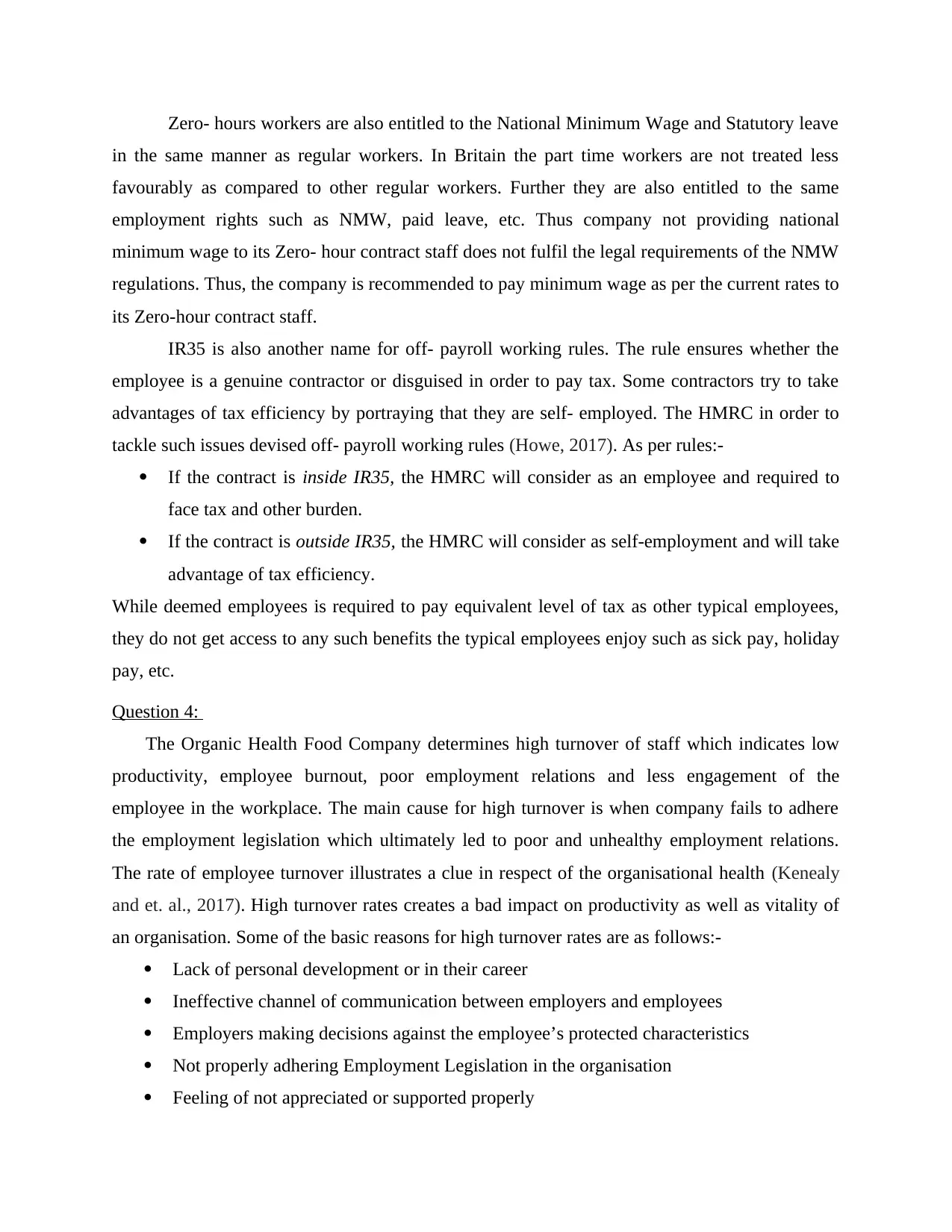
Zero- hours workers are also entitled to the National Minimum Wage and Statutory leave
in the same manner as regular workers. In Britain the part time workers are not treated less
favourably as compared to other regular workers. Further they are also entitled to the same
employment rights such as NMW, paid leave, etc. Thus company not providing national
minimum wage to its Zero- hour contract staff does not fulfil the legal requirements of the NMW
regulations. Thus, the company is recommended to pay minimum wage as per the current rates to
its Zero-hour contract staff.
IR35 is also another name for off- payroll working rules. The rule ensures whether the
employee is a genuine contractor or disguised in order to pay tax. Some contractors try to take
advantages of tax efficiency by portraying that they are self- employed. The HMRC in order to
tackle such issues devised off- payroll working rules (Howe, 2017). As per rules:-
If the contract is inside IR35, the HMRC will consider as an employee and required to
face tax and other burden.
If the contract is outside IR35, the HMRC will consider as self-employment and will take
advantage of tax efficiency.
While deemed employees is required to pay equivalent level of tax as other typical employees,
they do not get access to any such benefits the typical employees enjoy such as sick pay, holiday
pay, etc.
Question 4:
The Organic Health Food Company determines high turnover of staff which indicates low
productivity, employee burnout, poor employment relations and less engagement of the
employee in the workplace. The main cause for high turnover is when company fails to adhere
the employment legislation which ultimately led to poor and unhealthy employment relations.
The rate of employee turnover illustrates a clue in respect of the organisational health (Kenealy
and et. al., 2017). High turnover rates creates a bad impact on productivity as well as vitality of
an organisation. Some of the basic reasons for high turnover rates are as follows:-
Lack of personal development or in their career
Ineffective channel of communication between employers and employees
Employers making decisions against the employee’s protected characteristics
Not properly adhering Employment Legislation in the organisation
Feeling of not appreciated or supported properly
in the same manner as regular workers. In Britain the part time workers are not treated less
favourably as compared to other regular workers. Further they are also entitled to the same
employment rights such as NMW, paid leave, etc. Thus company not providing national
minimum wage to its Zero- hour contract staff does not fulfil the legal requirements of the NMW
regulations. Thus, the company is recommended to pay minimum wage as per the current rates to
its Zero-hour contract staff.
IR35 is also another name for off- payroll working rules. The rule ensures whether the
employee is a genuine contractor or disguised in order to pay tax. Some contractors try to take
advantages of tax efficiency by portraying that they are self- employed. The HMRC in order to
tackle such issues devised off- payroll working rules (Howe, 2017). As per rules:-
If the contract is inside IR35, the HMRC will consider as an employee and required to
face tax and other burden.
If the contract is outside IR35, the HMRC will consider as self-employment and will take
advantage of tax efficiency.
While deemed employees is required to pay equivalent level of tax as other typical employees,
they do not get access to any such benefits the typical employees enjoy such as sick pay, holiday
pay, etc.
Question 4:
The Organic Health Food Company determines high turnover of staff which indicates low
productivity, employee burnout, poor employment relations and less engagement of the
employee in the workplace. The main cause for high turnover is when company fails to adhere
the employment legislation which ultimately led to poor and unhealthy employment relations.
The rate of employee turnover illustrates a clue in respect of the organisational health (Kenealy
and et. al., 2017). High turnover rates creates a bad impact on productivity as well as vitality of
an organisation. Some of the basic reasons for high turnover rates are as follows:-
Lack of personal development or in their career
Ineffective channel of communication between employers and employees
Employers making decisions against the employee’s protected characteristics
Not properly adhering Employment Legislation in the organisation
Feeling of not appreciated or supported properly
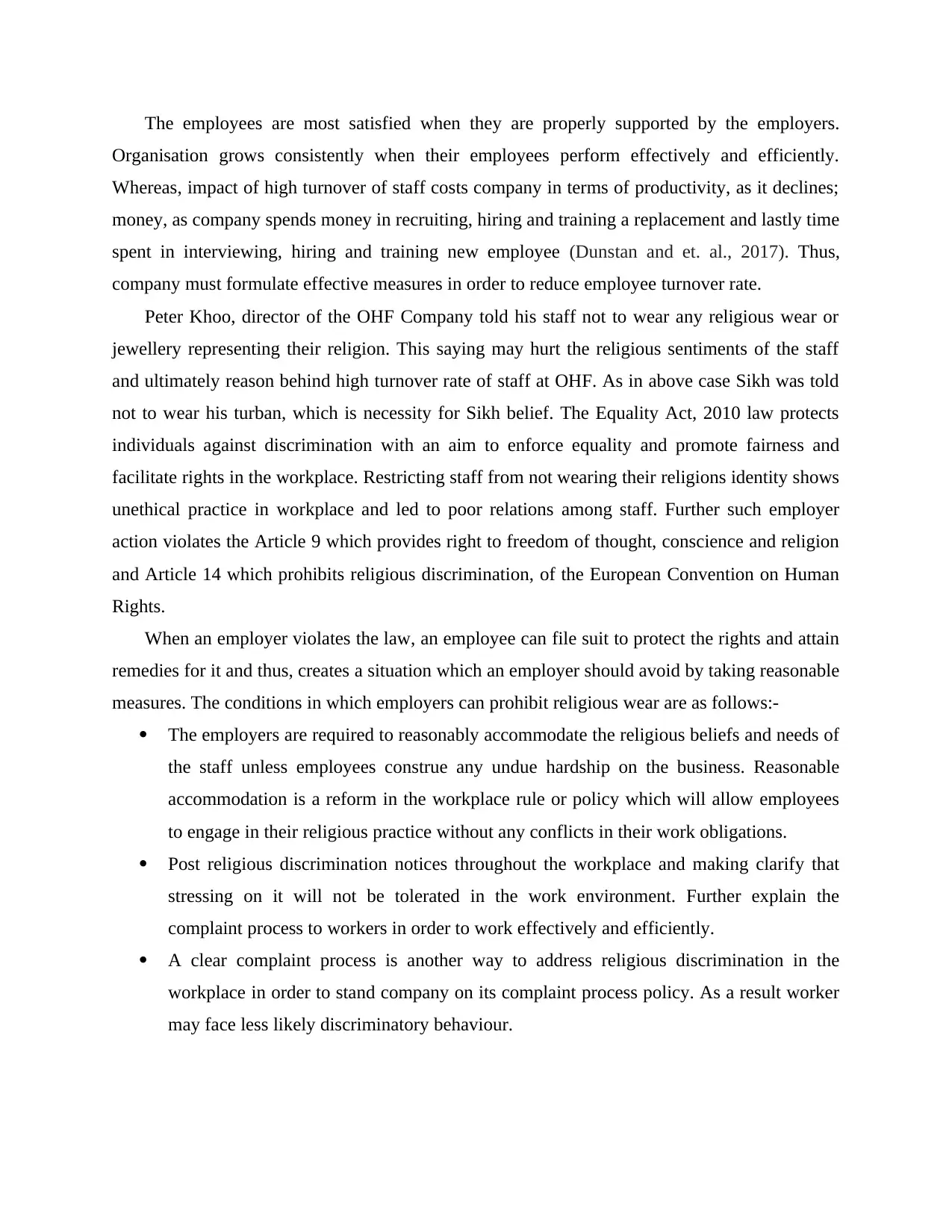
The employees are most satisfied when they are properly supported by the employers.
Organisation grows consistently when their employees perform effectively and efficiently.
Whereas, impact of high turnover of staff costs company in terms of productivity, as it declines;
money, as company spends money in recruiting, hiring and training a replacement and lastly time
spent in interviewing, hiring and training new employee (Dunstan and et. al., 2017). Thus,
company must formulate effective measures in order to reduce employee turnover rate.
Peter Khoo, director of the OHF Company told his staff not to wear any religious wear or
jewellery representing their religion. This saying may hurt the religious sentiments of the staff
and ultimately reason behind high turnover rate of staff at OHF. As in above case Sikh was told
not to wear his turban, which is necessity for Sikh belief. The Equality Act, 2010 law protects
individuals against discrimination with an aim to enforce equality and promote fairness and
facilitate rights in the workplace. Restricting staff from not wearing their religions identity shows
unethical practice in workplace and led to poor relations among staff. Further such employer
action violates the Article 9 which provides right to freedom of thought, conscience and religion
and Article 14 which prohibits religious discrimination, of the European Convention on Human
Rights.
When an employer violates the law, an employee can file suit to protect the rights and attain
remedies for it and thus, creates a situation which an employer should avoid by taking reasonable
measures. The conditions in which employers can prohibit religious wear are as follows:-
The employers are required to reasonably accommodate the religious beliefs and needs of
the staff unless employees construe any undue hardship on the business. Reasonable
accommodation is a reform in the workplace rule or policy which will allow employees
to engage in their religious practice without any conflicts in their work obligations.
Post religious discrimination notices throughout the workplace and making clarify that
stressing on it will not be tolerated in the work environment. Further explain the
complaint process to workers in order to work effectively and efficiently.
A clear complaint process is another way to address religious discrimination in the
workplace in order to stand company on its complaint process policy. As a result worker
may face less likely discriminatory behaviour.
Organisation grows consistently when their employees perform effectively and efficiently.
Whereas, impact of high turnover of staff costs company in terms of productivity, as it declines;
money, as company spends money in recruiting, hiring and training a replacement and lastly time
spent in interviewing, hiring and training new employee (Dunstan and et. al., 2017). Thus,
company must formulate effective measures in order to reduce employee turnover rate.
Peter Khoo, director of the OHF Company told his staff not to wear any religious wear or
jewellery representing their religion. This saying may hurt the religious sentiments of the staff
and ultimately reason behind high turnover rate of staff at OHF. As in above case Sikh was told
not to wear his turban, which is necessity for Sikh belief. The Equality Act, 2010 law protects
individuals against discrimination with an aim to enforce equality and promote fairness and
facilitate rights in the workplace. Restricting staff from not wearing their religions identity shows
unethical practice in workplace and led to poor relations among staff. Further such employer
action violates the Article 9 which provides right to freedom of thought, conscience and religion
and Article 14 which prohibits religious discrimination, of the European Convention on Human
Rights.
When an employer violates the law, an employee can file suit to protect the rights and attain
remedies for it and thus, creates a situation which an employer should avoid by taking reasonable
measures. The conditions in which employers can prohibit religious wear are as follows:-
The employers are required to reasonably accommodate the religious beliefs and needs of
the staff unless employees construe any undue hardship on the business. Reasonable
accommodation is a reform in the workplace rule or policy which will allow employees
to engage in their religious practice without any conflicts in their work obligations.
Post religious discrimination notices throughout the workplace and making clarify that
stressing on it will not be tolerated in the work environment. Further explain the
complaint process to workers in order to work effectively and efficiently.
A clear complaint process is another way to address religious discrimination in the
workplace in order to stand company on its complaint process policy. As a result worker
may face less likely discriminatory behaviour.
⊘ This is a preview!⊘
Do you want full access?
Subscribe today to unlock all pages.

Trusted by 1+ million students worldwide
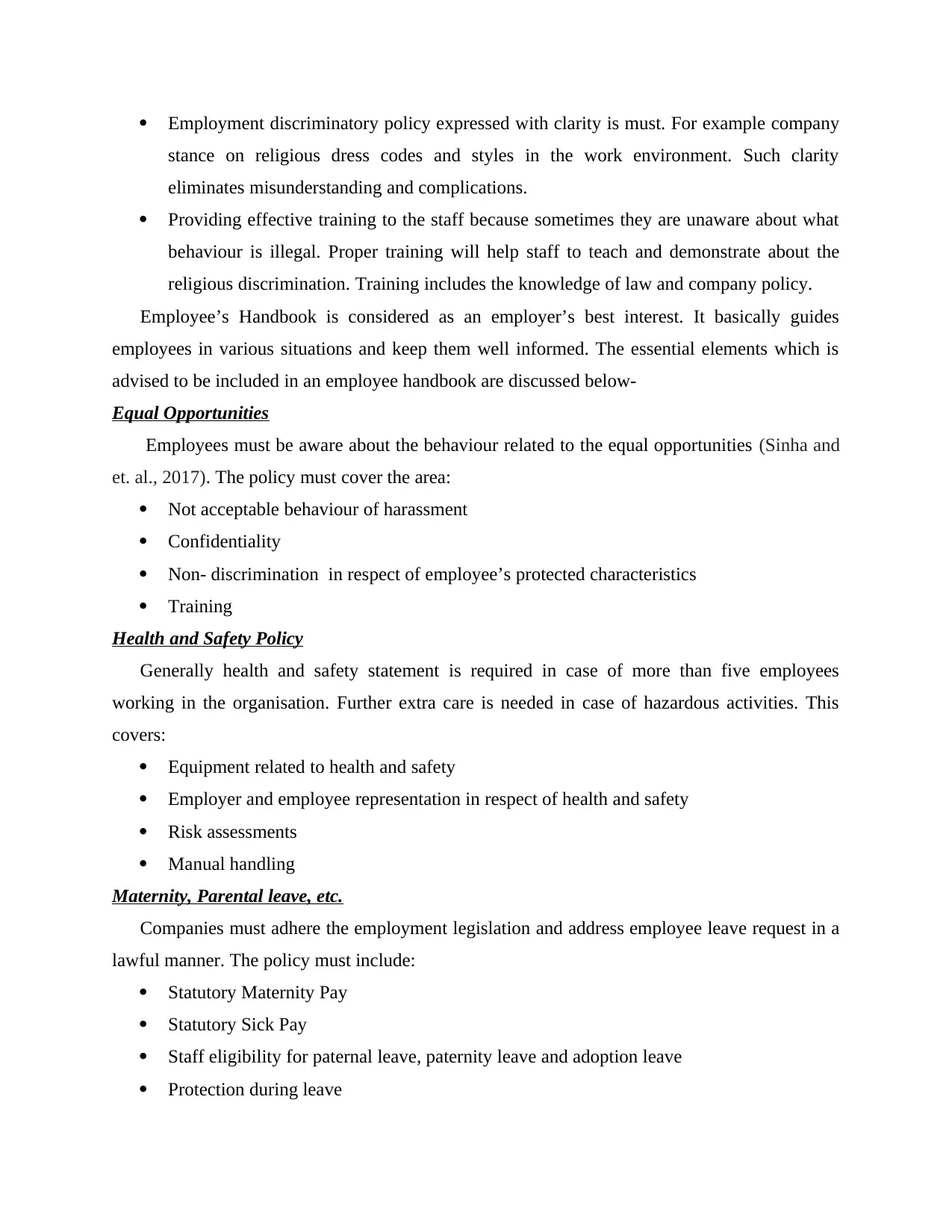
Employment discriminatory policy expressed with clarity is must. For example company
stance on religious dress codes and styles in the work environment. Such clarity
eliminates misunderstanding and complications.
Providing effective training to the staff because sometimes they are unaware about what
behaviour is illegal. Proper training will help staff to teach and demonstrate about the
religious discrimination. Training includes the knowledge of law and company policy.
Employee’s Handbook is considered as an employer’s best interest. It basically guides
employees in various situations and keep them well informed. The essential elements which is
advised to be included in an employee handbook are discussed below-
Equal Opportunities
Employees must be aware about the behaviour related to the equal opportunities (Sinha and
et. al., 2017). The policy must cover the area:
Not acceptable behaviour of harassment
Confidentiality
Non- discrimination in respect of employee’s protected characteristics
Training
Health and Safety Policy
Generally health and safety statement is required in case of more than five employees
working in the organisation. Further extra care is needed in case of hazardous activities. This
covers:
Equipment related to health and safety
Employer and employee representation in respect of health and safety
Risk assessments
Manual handling
Maternity, Parental leave, etc.
Companies must adhere the employment legislation and address employee leave request in a
lawful manner. The policy must include:
Statutory Maternity Pay
Statutory Sick Pay
Staff eligibility for paternal leave, paternity leave and adoption leave
Protection during leave
stance on religious dress codes and styles in the work environment. Such clarity
eliminates misunderstanding and complications.
Providing effective training to the staff because sometimes they are unaware about what
behaviour is illegal. Proper training will help staff to teach and demonstrate about the
religious discrimination. Training includes the knowledge of law and company policy.
Employee’s Handbook is considered as an employer’s best interest. It basically guides
employees in various situations and keep them well informed. The essential elements which is
advised to be included in an employee handbook are discussed below-
Equal Opportunities
Employees must be aware about the behaviour related to the equal opportunities (Sinha and
et. al., 2017). The policy must cover the area:
Not acceptable behaviour of harassment
Confidentiality
Non- discrimination in respect of employee’s protected characteristics
Training
Health and Safety Policy
Generally health and safety statement is required in case of more than five employees
working in the organisation. Further extra care is needed in case of hazardous activities. This
covers:
Equipment related to health and safety
Employer and employee representation in respect of health and safety
Risk assessments
Manual handling
Maternity, Parental leave, etc.
Companies must adhere the employment legislation and address employee leave request in a
lawful manner. The policy must include:
Statutory Maternity Pay
Statutory Sick Pay
Staff eligibility for paternal leave, paternity leave and adoption leave
Protection during leave
Paraphrase This Document
Need a fresh take? Get an instant paraphrase of this document with our AI Paraphraser
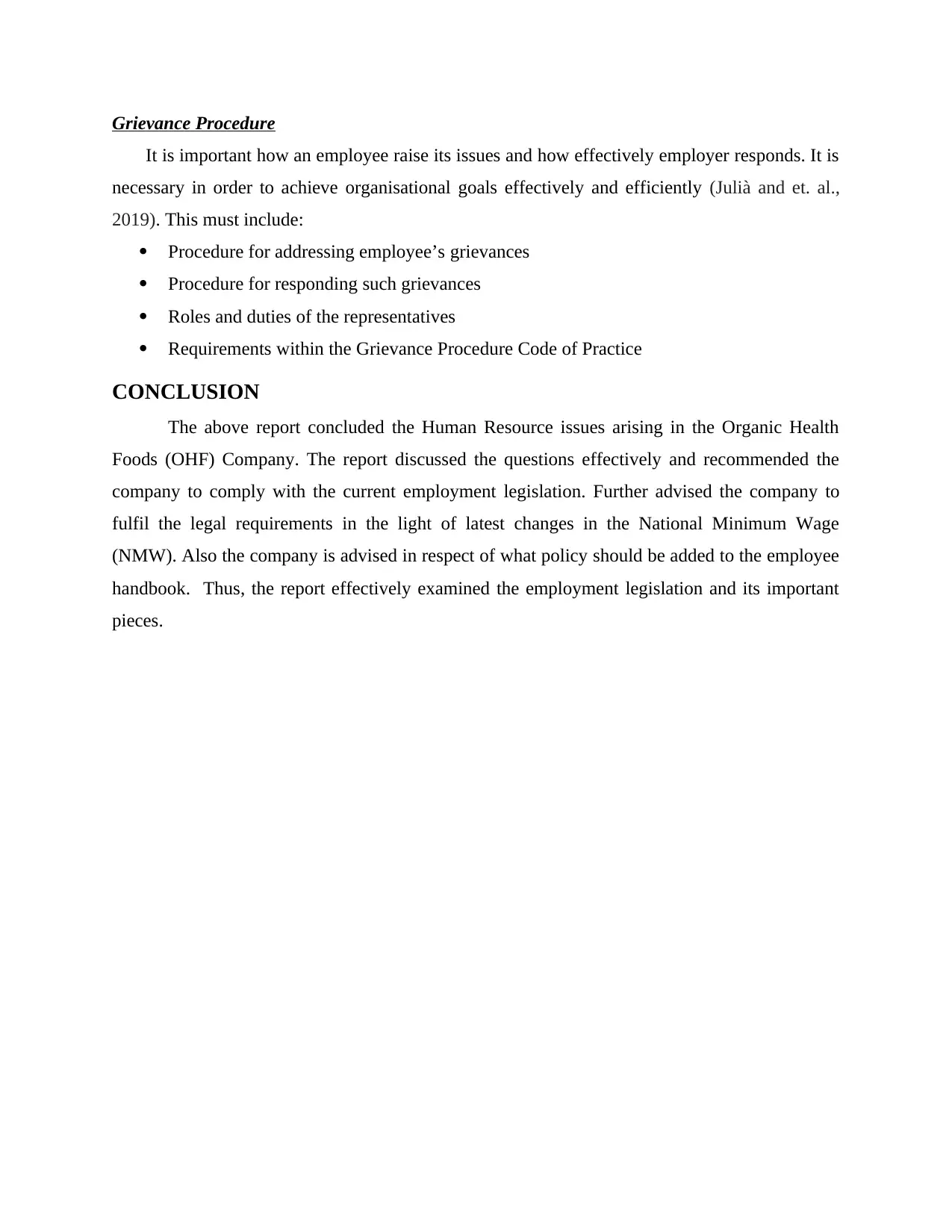
Grievance Procedure
It is important how an employee raise its issues and how effectively employer responds. It is
necessary in order to achieve organisational goals effectively and efficiently (Julià and et. al.,
2019). This must include:
Procedure for addressing employee’s grievances
Procedure for responding such grievances
Roles and duties of the representatives
Requirements within the Grievance Procedure Code of Practice
CONCLUSION
The above report concluded the Human Resource issues arising in the Organic Health
Foods (OHF) Company. The report discussed the questions effectively and recommended the
company to comply with the current employment legislation. Further advised the company to
fulfil the legal requirements in the light of latest changes in the National Minimum Wage
(NMW). Also the company is advised in respect of what policy should be added to the employee
handbook. Thus, the report effectively examined the employment legislation and its important
pieces.
It is important how an employee raise its issues and how effectively employer responds. It is
necessary in order to achieve organisational goals effectively and efficiently (Julià and et. al.,
2019). This must include:
Procedure for addressing employee’s grievances
Procedure for responding such grievances
Roles and duties of the representatives
Requirements within the Grievance Procedure Code of Practice
CONCLUSION
The above report concluded the Human Resource issues arising in the Organic Health
Foods (OHF) Company. The report discussed the questions effectively and recommended the
company to comply with the current employment legislation. Further advised the company to
fulfil the legal requirements in the light of latest changes in the National Minimum Wage
(NMW). Also the company is advised in respect of what policy should be added to the employee
handbook. Thus, the report effectively examined the employment legislation and its important
pieces.
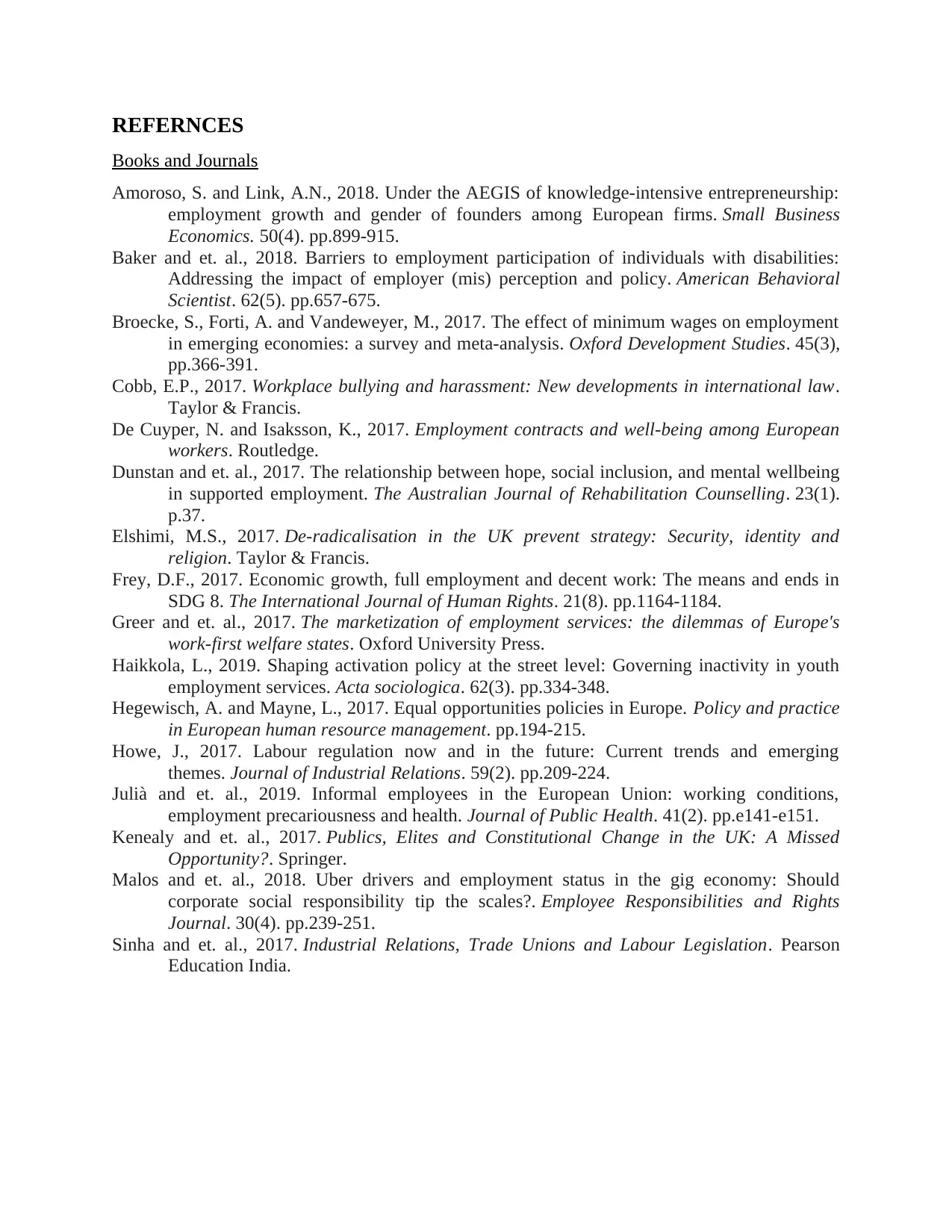
REFERNCES
Books and Journals
Amoroso, S. and Link, A.N., 2018. Under the AEGIS of knowledge-intensive entrepreneurship:
employment growth and gender of founders among European firms. Small Business
Economics. 50(4). pp.899-915.
Baker and et. al., 2018. Barriers to employment participation of individuals with disabilities:
Addressing the impact of employer (mis) perception and policy. American Behavioral
Scientist. 62(5). pp.657-675.
Broecke, S., Forti, A. and Vandeweyer, M., 2017. The effect of minimum wages on employment
in emerging economies: a survey and meta-analysis. Oxford Development Studies. 45(3),
pp.366-391.
Cobb, E.P., 2017. Workplace bullying and harassment: New developments in international law.
Taylor & Francis.
De Cuyper, N. and Isaksson, K., 2017. Employment contracts and well-being among European
workers. Routledge.
Dunstan and et. al., 2017. The relationship between hope, social inclusion, and mental wellbeing
in supported employment. The Australian Journal of Rehabilitation Counselling. 23(1).
p.37.
Elshimi, M.S., 2017. De-radicalisation in the UK prevent strategy: Security, identity and
religion. Taylor & Francis.
Frey, D.F., 2017. Economic growth, full employment and decent work: The means and ends in
SDG 8. The International Journal of Human Rights. 21(8). pp.1164-1184.
Greer and et. al., 2017. The marketization of employment services: the dilemmas of Europe's
work-first welfare states. Oxford University Press.
Haikkola, L., 2019. Shaping activation policy at the street level: Governing inactivity in youth
employment services. Acta sociologica. 62(3). pp.334-348.
Hegewisch, A. and Mayne, L., 2017. Equal opportunities policies in Europe. Policy and practice
in European human resource management. pp.194-215.
Howe, J., 2017. Labour regulation now and in the future: Current trends and emerging
themes. Journal of Industrial Relations. 59(2). pp.209-224.
Julià and et. al., 2019. Informal employees in the European Union: working conditions,
employment precariousness and health. Journal of Public Health. 41(2). pp.e141-e151.
Kenealy and et. al., 2017. Publics, Elites and Constitutional Change in the UK: A Missed
Opportunity?. Springer.
Malos and et. al., 2018. Uber drivers and employment status in the gig economy: Should
corporate social responsibility tip the scales?. Employee Responsibilities and Rights
Journal. 30(4). pp.239-251.
Sinha and et. al., 2017. Industrial Relations, Trade Unions and Labour Legislation. Pearson
Education India.
Books and Journals
Amoroso, S. and Link, A.N., 2018. Under the AEGIS of knowledge-intensive entrepreneurship:
employment growth and gender of founders among European firms. Small Business
Economics. 50(4). pp.899-915.
Baker and et. al., 2018. Barriers to employment participation of individuals with disabilities:
Addressing the impact of employer (mis) perception and policy. American Behavioral
Scientist. 62(5). pp.657-675.
Broecke, S., Forti, A. and Vandeweyer, M., 2017. The effect of minimum wages on employment
in emerging economies: a survey and meta-analysis. Oxford Development Studies. 45(3),
pp.366-391.
Cobb, E.P., 2017. Workplace bullying and harassment: New developments in international law.
Taylor & Francis.
De Cuyper, N. and Isaksson, K., 2017. Employment contracts and well-being among European
workers. Routledge.
Dunstan and et. al., 2017. The relationship between hope, social inclusion, and mental wellbeing
in supported employment. The Australian Journal of Rehabilitation Counselling. 23(1).
p.37.
Elshimi, M.S., 2017. De-radicalisation in the UK prevent strategy: Security, identity and
religion. Taylor & Francis.
Frey, D.F., 2017. Economic growth, full employment and decent work: The means and ends in
SDG 8. The International Journal of Human Rights. 21(8). pp.1164-1184.
Greer and et. al., 2017. The marketization of employment services: the dilemmas of Europe's
work-first welfare states. Oxford University Press.
Haikkola, L., 2019. Shaping activation policy at the street level: Governing inactivity in youth
employment services. Acta sociologica. 62(3). pp.334-348.
Hegewisch, A. and Mayne, L., 2017. Equal opportunities policies in Europe. Policy and practice
in European human resource management. pp.194-215.
Howe, J., 2017. Labour regulation now and in the future: Current trends and emerging
themes. Journal of Industrial Relations. 59(2). pp.209-224.
Julià and et. al., 2019. Informal employees in the European Union: working conditions,
employment precariousness and health. Journal of Public Health. 41(2). pp.e141-e151.
Kenealy and et. al., 2017. Publics, Elites and Constitutional Change in the UK: A Missed
Opportunity?. Springer.
Malos and et. al., 2018. Uber drivers and employment status in the gig economy: Should
corporate social responsibility tip the scales?. Employee Responsibilities and Rights
Journal. 30(4). pp.239-251.
Sinha and et. al., 2017. Industrial Relations, Trade Unions and Labour Legislation. Pearson
Education India.
⊘ This is a preview!⊘
Do you want full access?
Subscribe today to unlock all pages.

Trusted by 1+ million students worldwide
1 out of 12
Related Documents
Your All-in-One AI-Powered Toolkit for Academic Success.
+13062052269
info@desklib.com
Available 24*7 on WhatsApp / Email
![[object Object]](/_next/static/media/star-bottom.7253800d.svg)
Unlock your academic potential
Copyright © 2020–2025 A2Z Services. All Rights Reserved. Developed and managed by ZUCOL.



